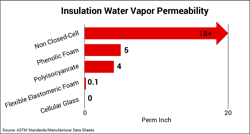Seeking Longevity: 3 Considerations for Setting the Spec for Chilled Water
Operating behind the scenes, the chilled water system of an airport plays a critical role in delivering comfort to those who work there as well as those who are passing through. The relative “open design” of the airport envelope presents thermal challenges as well as moisture infiltration risks. And because this network of pipes is not easily accessed, remediation to address maintenance or retrofit issues can be extremely costly and disruptive. For that reason, it makes sense to design longevity into the system, starting with the specification of insulating materials.
High-performing insulating systems show it is possible to design and install insulation that preserves the long-term, efficient function of the chilled water system. Three areas of focus include accounting for moisture and humidity, selecting the correct materials, and addressing indoor and outdoor climate and operating complications.
Consideration 1: Protect against moisture-based damage
Chilled water lines function from about 36°F (2.22°C) to 50-55°F (10-12.77°C). These temperatures tend to be below ambient conditions, leaving pipes at risk of collecting condensation. Moisture poses the main threat to long-term, efficient function of a chilled water system – especially when the vapor barrier protecting the insulated system is breached and the insulation used is permeable. If moisture gains access to the insulation, it can cause visible and hidden problems including dripping, mold and mildew growth and development of corrosion under insulation (CUI).
Additionally, moisture that penetrates a damaged vapor barrier can be absorbed by permeable types of insulation. Damp insulation creates a thermal bridge that reduces system efficiency and thermal performance. Thermal bridging causes chilled water lines to gain more heat than desired. This leads to increased energy usage, higher costs, and diminished cooling in the airport enclosure. It also places additional stress on equipment.
Considering protections from moisture
When addressing moisture-based risk and insulating material selection, the humidity, relative humidity, vapor pressure and dew point need to be considered.
Humidity is the amount of water vapor in the air and relative humidity is the percentage of water vapor present compared to how much moisture can be held by the air. Relative humidity varies with changing conditions including air temperature and barometric pressure.
Vapor pressure is the equilibrium where water exists as both a liquid and a vapor and like other types of pressure it seeks to equalize when imbalanced. When warm, humid air encounters a cold pipe, it condenses on the pipe surface until a new balance is reached. The temperature at which this condensation begins to occur is the dew point. As condensation occurs on the surface of a cold pipe, a vapor drive is established which forces warm moist air through insulation toward the cold pipe. This causes additional condensation. This process will continue unless prevented with a vapor barrier.
Vapor barriers on chilled water pipe insulation can be compromised by poor installation or by damage from other activities including maintenance and traffic. If permeable insulation is use, the system is totally reliant on an intact vapor barrier to prevent moisture from entering. Once the vapor barrier is breached, permeable insulation will allow moisture to reach the surface of chilled pipes and condense. In addition, the insulation itself will likely absorb or retain water. This increases the U-value (thermal transmittance) of the system which will result in reduced external temperature on the surface of the system. This in turn will increase the likelihood of surface condensation.
Designing an insulation system that maintains an outer temperature above the dew point helps prevent condensation from occurring on the outside of the insulation. This moves the dew point to a position within the insulation but if the outer surface remains above the dew point and the vapor barrier remains intact, moisture infiltration due to vapor drive will be prevented.
There are multiple standards that can be used to guide the design of an insulating system for chilled water pipes. A commonly referenced standard is ASHRAE 90.1 — Energy Standard for Buildings Except Low-rise Residential Buildings — which relates to energy conservation. It is important to remember that insulation thickness needs to be calculated based on the parameters and local conditions a specific system will face.
Consideration 2: Evaluate material properties
The insulation systems used to protect chilled water lines tend to have multiple components, including insulation, sealants, and jacketing. Jacketing can have different levels of emissivity or absorb and emit different amounts of heat. Materials with a high emissivity, like PVC or ASJ, can be used to help raise the temperature of the outer edge of the insulated system lowering the risk of surface condensation.
Additionally, there are a range of material types that can be used to provide insulation. However, selecting a closed-cell, impermeable insulation – like FOAMGLAS cellular glass insulation – helps address several of the challenges that chilled water systems face. Cellular glass insulation is impermeable to vapor, moisture, and is non-absorbent. It is a rigid and lightweight material with a relatively high compressive strength. This means in many cases the insulation can be used to carry the load of the pipe and contents and can also support the overburden in direct buried applications without crushing or deformation. The material also has a dimensional stability similar to carbon steel. Being made of glass, it is non-combustible, does not generate toxic smoke and is chemically inert. At the same time, it remains easy to cut and can be prefabricated into a range of shapes.
Consideration 3: Address indoor and outdoor challenges
When chilled water pipes are used indoors there are a number of items to consider. In airport environments, breaches to the building envelope are a pervasive challenge. Large doors that frequently open, terminal gates and outdoor openings in baggage claim areas, are some of the locations where non-conditioned, high humidity air can enter a facility.
These areas provide increased opportunity for condensation to occur — especially in locations prone to hot, humid conditions, or extreme weather.
There also are several conditions to consider during insulation design for pipes that will run outside. For exposed pipes, protection from UV rays, weather, and chemicals spills or fumes (i.e., jet fuel), can be important. Pipes that are direct buried need insulation with sufficient compressive strength to support the weight of backfill and traffic.
Whether located inside or outside, insulation systems need to be designed to function in the expected conditions, including high humidity, potential flooding, and variations in weather.
Designing for long-term performance
There are several factors to consider when designing insulation to protect a chilled water system – especially in regions with high humidity and ambient temperatures. However, by assessing local challenges, anticipating worst-case situations and choosing impermeable insulation, it is possible to design and install a system that provides for long-term, efficient function of a facility’s chilled water system and avoid the high cost of reinstallation or refurbishment.



